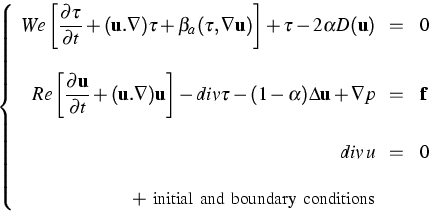|
|
|
[Contents] | [Index] |
Description:
In nature, there are many fluids that do not satisfy the Newtonian constitutive law. This is also the case for many fluids created for industrial purposes. Fluids like multi-grade oils, liquid detergents, shampoos, dyes, adhesives, biological fluids like blood, paints, greases, printing inks, industrial suspensions, polymer solutions, and polymer melts, fall within the category of non-Newtonian fluids. First, the Oldroyd-A and -B fluid models are considered but the intention is to study the behavior of the generalized Oldroyd-B model, introduced by Yeleswarapu in [8], which is an up-to-date model for blood. The projected investigations could be transferred to the case of a blood-centrifuge (with bio-medical practice at the dialysis).
The numerical simulation of many industrial problems has been carried
out using viscoelastic models of the Oldroyd kind.
As unknowns there are the tensorial stress-field ![]() ,
the vectorial velocity-field u, and the scalar pressure-field p.
The dimensionless constitutive, momentum and continuity equations for
the Oldroyd model yield the following system:
,
the vectorial velocity-field u, and the scalar pressure-field p.
The dimensionless constitutive, momentum and continuity equations for
the Oldroyd model yield the following system:

 and
and
Three parameters characterize the flow: the Reynolds number ![]() ,
the fraction of viscoelastic viscosity
,
the fraction of viscoelastic viscosity ![]() , and
the Weissenberg number
, and
the Weissenberg number ![]() . This system includes the Navier-Stokes system
as a particular case (We=0), so it is favorable to develop a numerical method
which can generalize an existing one used for the Navier-Stokes system.
. This system includes the Navier-Stokes system
as a particular case (We=0), so it is favorable to develop a numerical method
which can generalize an existing one used for the Navier-Stokes system.
There are two aspects which should be addressed for this system: the finite-element spatial discretization and the time discretization.
The solution of the Oldroyd problem by the finite-element method presents a difficulty due to the
hyperbolic character of the constitutive equation, which is to be considered as a system in ![]() with
with
![]() fixed (the mathematical nature of the global system is a difficult problem; loss
of evolution and change of type can occur for
fixed (the mathematical nature of the global system is a difficult problem; loss
of evolution and change of type can occur for ![]() ). For some
years the numerical solution
of the Oldroyd system with convenient boundary conditions on
). For some
years the numerical solution
of the Oldroyd system with convenient boundary conditions on ![]() and
and ![]() was limited
to the small Weissenberg number, because the hyperbolic character of the constitutive equation was
not taken into account. This hyperbolic nature implies that some upwinding is needed.
The choice of upwinding techniques depends on the choice of the finite-element space used to
approximate
was limited
to the small Weissenberg number, because the hyperbolic character of the constitutive equation was
not taken into account. This hyperbolic nature implies that some upwinding is needed.
The choice of upwinding techniques depends on the choice of the finite-element space used to
approximate ![]() . Since no continuity requirement is needed on
. Since no continuity requirement is needed on ![]() at interfaces between
elements, as shown in [2], this will be done by using the
discontinuous Galerkin method, which allows the computation of
at interfaces between
elements, as shown in [2], this will be done by using the
discontinuous Galerkin method, which allows the computation of ![]() on an element by
element basis.
on an element by
element basis.
For fixed ![]() , the last two equations comprise a Stokes system in the variables
, the last two equations comprise a Stokes system in the variables ![]() and p.
To solve the Stokes system, a mixed finite-element method was used:
the stable Taylor-Hood element was implemented
on unstructured simplicial grids in 2-d and 3-d, i.e. piecewise-quadratic basis
functions for the velocity and piecewise-linear for the pressure.
and p.
To solve the Stokes system, a mixed finite-element method was used:
the stable Taylor-Hood element was implemented
on unstructured simplicial grids in 2-d and 3-d, i.e. piecewise-quadratic basis
functions for the velocity and piecewise-linear for the pressure.
Major numerical problems for the unsteady Oldroyd system arise due to:
For the Navier-Stokes equations this scheme is 2nd order accurate,
non-dissipative, and A-stable. Stability and convergence analysis of the
fractional step ![]() -scheme for the unsteady Navier-Stokes equations are proven in
[4] and [5].
Due to the complexity of the splitting method for the Oldroyd system,
only the stability in the linearized case could be proven.
-scheme for the unsteady Navier-Stokes equations are proven in
[4] and [5].
Due to the complexity of the splitting method for the Oldroyd system,
only the stability in the linearized case could be proven.
The splitting technique leads to three subproblems, a linear Stokes-like one, a nonlinear Burger-like one, and a stress-tensor transport problem. The first two subproblems have been solved by the finite-element methods described below and the last is in progress.
The method has been implemented in ALBERT, an adaptive finite-element toolbox ([7]).
References:
http://www.mathematik.uni-freiburg.de/IAM/Research/projectsdz/albert .
|
|
|
[Contents] | [Index] |